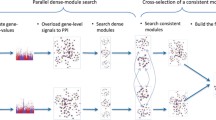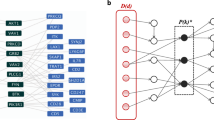Abstract
Co-existence of bronchial asthma (BA) and tuberculosis (TB) is extremely uncommon (dystropic). We assume that this is caused by the interplay between genes involved into specific pathophysiological pathways that arrest simultaneous manifestation of BA and TB. Identification of common and specific genes may be important to determine the molecular genetic mechanisms leading to rare co-occurrence of these diseases and may contribute to the identification of susceptibility genes for each of these dystropic diseases. To address the issue, we propose a new methodological strategy that is based on reconstruction of associative networks that represent molecular relationships between proteins/genes associated with BA and TB, thus facilitating a better understanding of the biological context of antagonistic relationships between the diseases. The results of our study revealed a number of proteins/genes important for the development of both BA and TB.



Similar content being viewed by others
References
Akbulut S, Sogutcu N, Yagmur Y (2011) Coexistence of breast cancer and tuberculosis in axillary lymph nodes: a case report and literature review. Breast Cancer Res Treat 130(3):1037–1042
Amer GA, El-Gazzar AG (2008) Circulating interleukin-18 and osteopontin in pulmonary tuberculosis patients and their correlation with disease activity. Egypt J Med Microbiol 17(3):405–410
Arjomandi M, Galanter JM, Choudhry S et al (2011) Polymorphism in osteopontin gene (SPP1) is associated with asthma and related phenotypes in a Puerto Rican population. Pediatr Allergy Immunol Pulmonol 24(4):207–214
Awomoyi AA, Charurat M, Marchant A, Miller EN, Blackwell JM, McAdam KP et al (2005) Polymorphism in IL1B: IL1B-511 association with tuberculosis and decreased lipopolysaccharide-induced IL-1beta in IFN-gamma primed ex-vivo whole blood assay. J Endotoxin Res 11(5):281–286
Bader JS, Chaudhuri A, Rothberg JM, Chant J (2003) Gaining confidence in high-throughput protein interaction networks. Nat Biotechnol 22(1):78–85
Ben-Hur A, Noble WS (2005) Kernel methods for predicting protein–protein interactions. Bioinformatics 21(suppl 1):i38–i46
Benjamini Y, Hochberg Y (1995) Controlling the false discovery rate: a practical and powerful approach to multiple testing. J R Stat Soc Ser B Methodol 289–300
Cao S, Luo PF, Li W, Tang WQ, Cong XN, Wei PM (2012) Vitamin D receptor genetic polymorphisms and tuberculosis among Chinese Han ethnic group. Chin Med J (Engl) 125(5):920–925
Catalá-López F, Suárez-Pinilla M, Suárez-Pinilla P (2014) Inverse and direct cancer comorbidity in people with central nervous system disorders: a meta-analysis of cancer incidence in 577,013 participants of 50 observational studies. Psychot Psychosom 83:89–105. doi:10.1159/000356498
Cernat T, Comanescu M, Alexandru D, Carlig V (2010) Simultaneous occurrence of other diseases among prison inmates with tuberculosis. Curr Health Sci J 36(3):143–146
Cho YR, Shi L, Ramanathan M, Zhang A (2008) A probabilistic framework to predict protein function from interaction data integrated with semantic knowledge. BMC bioinforma 9(1):382. doi:10.1186/1471-2105-9-382
Christensen U, Haagerup A, Binderup HG, Vestbo J, Kruse TA, Børglum AD (2006) Family based association analysis of the IL2 and IL15 genes in allergic disorders. Eur J Hum Genet 14:227–235
Demenkov P, Ivanisenko T, Kolchanov N, Ivanisenko V (2011) ANDVisio: a new tool for graphic visualization and analysis of literature mined associative gene networks in the ANDSystem. In silico biol 11:149–161. doi:10.3233/ISB-2012-0449
Dimmer E, Huntley R, Alam-Faruque Y et al (2012) The UniProt-GO Annotation database in 2011. Nucleic Acids Res 40:D565–D570. doi:10.1093/nar/gkr1048
Douni E, Kollias G (1998) A critical role of the p75 tumor necrosis factor receptor (p75TNF-R) in organ inflammation independent of TNF, lymphotoxin alpha, or the p55TNF-R. J Exp Med 188(7):1343–1352
Feinstein AR (1970) Pre-therapeutic classification of co-morbidity in chronic disease. J Chron Dis 23(7):455–468
Fekih L, Boussoffara L, Jemaa M, Fenniche S, Hassene H, Belhabib D, Megdiche ML (2010) Tuberculosis in patients with asthma. Rev Mal Respir 27(7):679–684
Franceschini A, Szklarczyk D, Frankild S et al (2013) STRING v9.1: protein-protein interaction networks, with increased coverage and integration. Nucleic Acids Res 41:D808–D815. doi:10.1093/nar/gks1094
Goh KI, Cusick ME, Valle D, Childs B, Vidal M, Barabasi AL (2007) The human disease network. Proc Natl Acad Sci U S A 104(21):8685–8690
Goldberg DS, Roth FP (2003) Assessing experimentally derived interactions in a small world. Proc Natl Acad Sci 100(8):4372–4376
Hirota T, Suzuki Y, Hasegawa K et al (2005) Functional haplotypes of IL-12B are associated with childhood atopic asthma. J Allergy Clin Immunol 116(4):789–795
Hoffmann SC, Stanley EM, Darrin Cox E, Craighead N, DiMercurio BS, Koziol DE, Harlan DM, Kirk AD, Blair PJ (2001) Association of cytokine polymorphic inheritance and in vitro cytokine production in anti-CD3/CD28-stimulated peripheral blood lymphocytes. Transplantation 72:1444–1450
Holloway JW, Yang IA, Holgate ST (2010) Genetics of allergic disease. J Allergy Clin Immunol 125(2 Suppl 2):S81–S94
Ibáñez K, Boullosa C, Tabarés-Seisdedos R et al (2014) Molecular evidence for the inverse comorbidity between central nervous system disorders and cancers detected by transcriptomic meta-analyses. PLoS Genet 10:e1004173. doi:10.1371/journal.pgen.1004173
Jaccard P (1912) The distribution of the flora in the alpine zone. 1. New Phytol 11(2):37–50
Jain J, Valge-Archer VE, Rao A (1992) Analysis of the AP-1 sites in the IL-2 promoter. J Immunol 148:1240–1250
Kaneko Y, Yatagai Y, Yamada H, Iijima H, Masuko H, Sakamoto T, Hizawa N (2013) The search for common pathways underlying asthma and COPD. Int J Chron Obstruct Pulm Dis 8:65–78. doi:10.2147/COPD.S39617
Kon OM, Sihra BS, Compton CH, Leonard TB, Kay AB, Barnes NC (1998) Randomised, dose-ranging, placebo-controlled study of chimeric antibody to CD4 (keliximab) in chronic severe asthma. Lancet 352(9134):1109–1113
Li X, Ampleford EJ, Howard TD, Moore WC, Torgerson DG, Li H, Busse WW, Castro M, Erzurum SC et al (2012) Genome-wide association studies of asthma indicate opposite immunopathogenesis direction from autoimmune diseases. J Allergy Clin Immunol 130(4):861–868. doi:10.1016/j.jaci.2012.04.041, e7
Maalmi H, Sassi FH, Berraies A, Ammar J, Hamzaoui K, Hamzaoui A (2013) Association of vitamin D receptor gene polymorphisms with susceptibility to asthma in Tunisian children: a case control study. Hum Immunol 74(2):234–240
Maere S, Heymans K, Kuiper M (2005) BiNGO: a Cytoscape plugin to assess overrepresentation of gene ontology categories in biological networks. Bioinformatics 21(16):3448–3449
Malde K, Coward E, Jonassen I (2003) Fast sequence clustering using a suffix array algorithm. Bioinformatics 19(10):1221–1226
Medoff BD, Sauty A, Tager AM, Maclean JA, Smith RN, Mathew A et al (2002) IFN-gamma-inducible protein 10 (CXCL10) contributes to airway hyperreactivity and airway inflammation in a mouse model of asthma. J Immunol 168(10):5278–5286
Paolini R, Poletti A, Ramazzina E, Menin C, Santacatterina M, Montagna M, Bonaldi L, Del Mistro A, Zamboni S, D’Andrea E (2000) Co-existence of cutaneous T-cell lymphoma and B hairy cell leukemia. Am J Hematol 64(3):197–202
Park S, Yang J-S, Shin Y-E, Park J, Jang SK, Kim S (2011) Protein localization as a principal feature of the etiology and comorbidity of genetic diseases. Mol Syst Biol 7:494. doi:10.1038/msb.2011.29
Pfaundler M, von Seht L (1921) Weiteres über Syntropie kindlicher Krankheitzustände. Z Kinderheilkd 30:298–313
Puzyrev VP, Freidin MB (2009) Genetic view on the phenomenon of combined diseases in man. Acta Nat 1:52–57
Puzyrev VP, Makeeva OA, Freidin MB (2010) Syntropy, genetic testing and personalized medicine. Per Med 7(4):399–405
Ravasz E, Somera AL, Mongru DA, Oltvai ZN, Barabásib AL (2002) Hierarchical organization of modularity in metabolic networks. Science 297(5586):1551–1555
Rzhetsky A, Wajngurt D, Park N, Zheng T (2007) Probing genetic overlap among complex human phenotypes. Proc Natl Acad Sci U S A 104:11694–11699
Saunders BM, Frank AA, Orme IM, Cooper AM (2002) CD4 is required for the development of a protective granulomatous response to pulmonary tuberculosis. Cell Immunol 216(1–2):65–72
Selvaraj P, Alagarasu K, Harishankar M, Vidyarani M, Nisha Rajeswari D, Narayanan PR (2008) Cytokine gene polymorphisms and cytokine levels in pulmonary tuberculosis. Cytokine 43(1):26–33
Shirtcliffe P, Weatherall M, Beasley R, International Study of Asthma and Allergies in Childhood (2002) An inverse correlation between estimated tuberculosis notification rates and asthma symptoms. Respirology 7(2):153–155
Smoot M, Ono K, Ruscheinski J, Wang PL, Ideker T (2011) Cytoscape 2.8: new features for data integration and network visualization. Bioinforma (Oxford, Engl) 27:431–432
Strachan DP (1989) Hay fever, hygiene, and household size. BMJ 299(6710):1259–1260
Syed F, Blakemore SJ, Wallace DM, Trower MK, Johnson M, Markham AF et al (1999) CCR7 (EBI1) receptor down-regulation in asthma: differential gene expression in human CD4+ T lymphocytes. QJM 92(8):463–471
Szalai C, Kozma GT, Nagy A, Bojszkó A, Krikovszky D, Szabó T, Falus A (2001) Polymorphism in the gene regulatory region of MCP-1 is associated with asthma susceptibility and severity. J Allergy Clin Immunol 108:375–381
Thye T, Nejentsev S, Intemann CD, Browne EN, Chinbuah MA, Gyapong J, Osei I, Owusu-Dabo E, Zeitels LR, Herb F, Horstmann RD, Meyer CG (2009) MCP-1 promoter variant-362C associated with protection from pulmonary tuberculosis in Ghana, West Africa. Hum Mol Genet 18:381–388
Tso HW, Lau YL, Tam CM, Wong HS, Chiang AK (2004) Associations between IL12B polymorphisms and tuberculosis in the Hong Kong Chinese population. J Infect Dis 190(5):913–919
Vermeirssen V, Barrasa MI, Hidalgo CA, Babon JA, Sequerra R, Doucette-Stamm L, Barabási AL, Walhout AJ (2007) Transcription factor modularity in a gene-centered C. elegans core neuronal protein–DNA interaction network. Genome Res 17(7):1061–1071
von Hertzen L, Klaukka T, Mattila H, Haahtela T (1999) Mycobacterium tuberculosis infection and the subsequent development of asthma and allergic conditions. J Allergy Clin Immunol 104(6):1211–1214
Wang JP, Rought SE, Corbeil J, Guiney DG (2003) Gene expression profiling detects patterns of human macrophage responses following Mycobacterium tuberculosis infection. FEMS Immunol Med Microbiol 39(2):163–172
Wjst M, Lichtner P, Meitinger T, Grimbacher B (2009) STAT3 single-nucleotide polymorphisms and STAT3 mutations associated with hyper-IgE syndrome are not responsible for increased serum IgE serum levels in asthma families. Eur J Hum Genet 17(3):352–356
Wu YJ, Yang X, Wang XX, Qiu MT, You YZ, Zhang ZX, Zhu SM, Xu L, Tang FL (2013) Association of vitamin D receptor BsmI gene polymorphism with risk of tuberculosis: a meta-analysis of 15 studies. PLoS One 8(6):e66944. doi:10.1371/journal.pone.0066944
Yu W, Gwinn M, Clyne M, Yesupriya A, Khoury MJ (2008) A navigator for human genome epidemiology. Nat Genet 40(2):124–125
Zeyrek D, Demir E, Alpman A, Ozkinay F, Gulen F, Tanac R (2008) Association of interleukin-1beta and interleukin-1 receptor antagonist gene polymorphisms in Turkish children with atopic asthma. Allergy Asthma Proc 29(5):468–474
Zhang B, Park BH, Karpinets T, Samatova NF (2008) From pull-down data to protein interaction networks and complexes with biological relevance. Bioinformatics 24(7):979–986
Zhang J, Chen Y, Nie XB et al (2011) Interleukin-10 polymorphisms and tuberculosis susceptibility: a meta-analysis. Int J Tuberc Lung Dis 15(5):594–601. doi:10.5588/ijtld.09.0703
Zheng XY, Guan WJ, Mao C et al (2013) Interleukin-10 promoter 1082/-819/-592 polymorphisms are associated with asthma susceptibility in Asians and atopic asthma: a meta-analysis. Lung. doi:10.1007/s00408-013-9519-8
Zhernakova A, van Diemen CC, Wijmenga C (2009) Detecting shared pathogenesis from the shared genetics of immune-related diseases. Nat Rev Genet 10:43–55
Acknowledgments
This work was financially supported by the President’s Grant for the Leading Scientific Schools of Russian Federation (5096.2014.4) and grant from the Federal Target Program Scientific and scientific-pedagogical personnel of innovative Russia for 2009–2013 years (contract number 8156) to E.Y.B., L.A.K., M.B.F., and V.P.P. and a project VI.61.1.2 and MES to E.S.T., P.S.D., V.A.I., and N.A.K.
Conflict of interest
The authors declare no conflict of interest.
Author information
Authors and Affiliations
Corresponding author
Rights and permissions
About this article
Cite this article
Bragina, E.Y., Tiys, E.S., Freidin, M.B. et al. Insights into pathophysiology of dystropy through the analysis of gene networks: an example of bronchial asthma and tuberculosis. Immunogenetics 66, 457–465 (2014). https://doi.org/10.1007/s00251-014-0786-1
Received:
Accepted:
Published:
Issue Date:
DOI: https://doi.org/10.1007/s00251-014-0786-1




